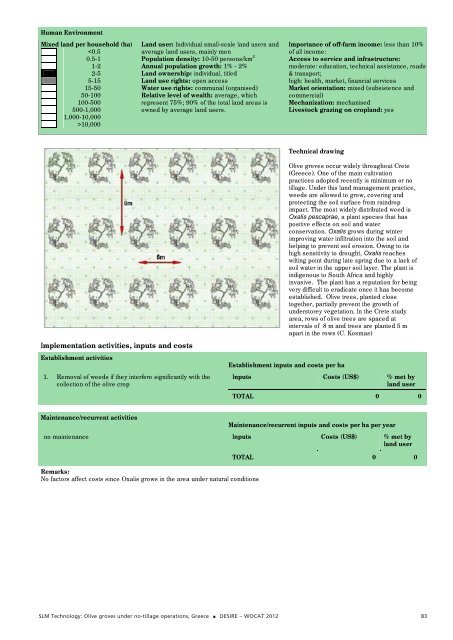Desire for Greener Land
Desire for Greener Land
Desire for Greener Land
Create successful ePaper yourself
Turn your PDF publications into a flip-book with our unique Google optimized e-Paper software.
Human Environment<br />
Mixed land per household (ha)<br />
10,000<br />
Implementation activities, inputs and costs<br />
Establishment activities<br />
<strong>Land</strong> user: Individual small-scale land users and<br />
average land users, mainly men<br />
Population density: 10-50 persons/km 2<br />
Annual population growth: 1% - 2%<br />
<strong>Land</strong> ownership: individual, titled<br />
<strong>Land</strong> use rights: open access<br />
Water use rights: communal (organised)<br />
Relative level of wealth: average, which<br />
represent 75%; 90% of the total land areas is<br />
owned by average land users.<br />
1. Removal of weeds if they interfere significantly with the<br />
collection of the olive crop<br />
Maintenance/recurrent activities<br />
SLM Technology: Olive groves under no-tillage operations, Greece DESIRE – WOCAT 2012<br />
Importance of off-farm income: less than 10%<br />
of all income:<br />
Access to service and infrastructure:<br />
moderate: education, technical assistance, roads<br />
& transport;<br />
high: health, market, financial services<br />
Market orientation: mixed (subsistence and<br />
commercial)<br />
Mechanization: mechanised<br />
Livestock grazing on cropland: yes<br />
Technical drawing<br />
Establishment inputs and costs per ha<br />
Olive groves occur widely throughout Crete<br />
(Greece). One of the main cultivation<br />
practices adopted recently is minimum or no<br />
tillage. Under this land management practice,<br />
weeds are allowed to grow, covering and<br />
protecting the soil surface from raindrop<br />
impact. The most widely distributed weed is<br />
Oxalis pescaprae, a plant species that has<br />
positive effects on soil and water<br />
conservation. Oxalis grows during winter<br />
improving water infiltration into the soil and<br />
helping to prevent soil erosion. Owing to its<br />
high sensitivity to drought, Oxalis reaches<br />
wilting point during late spring due to a lack of<br />
soil water in the upper soil layer. The plant is<br />
indigenous to South Africa and highly<br />
invasive. The plant has a reputation <strong>for</strong> being<br />
very difficult to eradicate once it has become<br />
established. Olive trees, planted close<br />
together, partially prevent the growth of<br />
understorey vegetation. In the Crete study<br />
area, rows of olive trees are spaced at<br />
intervals of 8 m and trees are planted 5 m<br />
apart in the rows (C. Kosmas)<br />
Inputs Costs (US$) % met by<br />
land user<br />
TOTAL 0 0<br />
Maintenance/recurrent inputs and costs per ha per year<br />
no maintenance Inputs Costs (US$) % met by<br />
land user<br />
Remarks:<br />
No factors affect costs since Oxalis grows in the area under natural conditions<br />
TOTAL 0 0<br />
83









